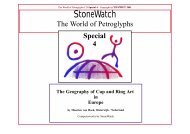petroglyphen im valle del encanto - StoneWatch
petroglyphen im valle del encanto - StoneWatch
petroglyphen im valle del encanto - StoneWatch
Erfolgreiche ePaper selbst erstellen
Machen Sie aus Ihren PDF Publikationen ein blätterbares Flipbook mit unserer einzigartigen Google optimierten e-Paper Software.
4. Some motifs, common on the mainland, do not occur in the<br />
Lesser Antilles but are found in the Greater Antilles; e.g. sun<br />
with rays, concentric circles, anthropomorphs with a frog-like<br />
body, anthropomorphs with a body formed by concentric diamonds.<br />
Conclusion:<br />
According to the history of the populating of the Antilles, s<strong>im</strong>ilarities<br />
in petroglyph designs can be expected. On the other hand,<br />
the diss<strong>im</strong>ilarities mentioned above point to cultural contacts of<br />
the Greater Antilles with other regions than the Lesser Antilles, or<br />
to autochtonic developments. The fact that in both regions anthropomorphs<br />
constitute by far the largest part of the petroglyphs, in<br />
our opinion emphasises the cultural correspondency.<br />
RELATIONS BETWEEN LESSER ANTILLES AND<br />
NORTH EAST SOUTH AMERICAN PETROGLYPHS<br />
The Lesser Antilles were populated from N. E. South America<br />
(see the paragraph; Archaeology of the area). Presuming that the<br />
Immigrants were the (principal) authors of the petroglyphs,<br />
which is probable but not certain, a relation in petroglyph shape<br />
may be expected between Lesser Antilles engravings and those<br />
of the Lower Orinoco, northeastern Venezuela, or the Guianas.<br />
Indeed, some s<strong>im</strong>ilarities exist:<br />
1. A special type of anthropomorphic drawing, which we called<br />
„Elaborate Type petroglyph“ exists in the N. E. part of the continent,<br />
especially in four of the five Guianas (Venezuelan,<br />
British, Dutch, and Brazilian Guiana). In St Vincent a drawing<br />
of this type occurs (Yambou no 2) which has its counterpart at<br />
the Wonotobo Falls, Corentijn River, Suriname (Fig 2).<br />
Fig. 2<br />
Elaborate type<br />
Drawing in St.<br />
Vincent<br />
Fig. 2a<br />
Elaborate Type<br />
Drawing<br />
at Wonotobo<br />
Falls, Corantyn<br />
River, Surinam<br />
2. The „body“ of a large anthropomorph may show parallel or<br />
crossing lines, connecting the sides. These body fillings occur<br />
frequently in both regions (Fig. 5).<br />
3. „S<strong>im</strong>ple faces“ (Fig. 3 which take up 37 % of Lesser Antilles<br />
petroglyphs, are also familiar in most parts of the mainland.<br />
7<br />
Fig. 5. Line Fillings in the Bodies of Anthropomorphs<br />
Only these few cases of s<strong>im</strong>ilarities could be noted down. On the<br />
other hand, figures which are common on the mainland do not or<br />
hardly occur in the Lesser Antilles. Motifs which we call curled<br />
shoulders, double spirals, double reversed spirals, frogs, human<br />
footprints, sun with rays (to be distinguished from human faces<br />
with a rayed hairdress or beard), etc (Fig. 3), which abound on<br />
the mainland, are lacking in the Lesser Antilles. In the preceding<br />
paragraph we already mentioned spirals and matchstick figures<br />
(Fig. 3). In our opinion, the spiral is the most common motif in<br />
South America. Matchstick figures also occur all over South<br />
America in our area, these figures do not appear, except for some<br />
spirals between the scrabbles of Buccament Bay, St Vincent or in<br />
cases where they are part of a larger drawing, e, g. on a boulder<br />
near the sea, South of Victoria, Grenada.<br />
On the other hand, typical motifs occur in the Antilles which are<br />
very scarce or totally absent on the mainland, eg.: eye and ear in<br />
one piece, head-feetpeople, double ears, head on rope (Fig. 3).<br />
Conclusion:<br />
People from South America settling down in the Lesser Antilles<br />
in prehistoric t<strong>im</strong>es seldom transferred the petroglyph motifs<br />
from the regions they originated from to their new surroundings.<br />
They developed their own rock art figures, which at best have<br />
some general properties in common with the drawings of the<br />
„old country“. These figures are predominantly anthropomorphic.<br />
Note. It shout be clear that the names we use for the various<br />
motifs are not meant in an interpretative way.<br />
INTERPRETATION<br />
A. General<br />
The term Interpretation covers three notions: 1. Pictorial interpretation,<br />
i. e. recognizing the figure itself; e. g. a jaguar, a boat,<br />
the sun, 2. Symbolic interpretation; e, g. a frog symbolizes rain<br />
or fertility. 3. Social interpretation, i.e. determining the function<br />
of petroglyph making in the community of the makers.<br />
Petroglyphs are more than products of playful past<strong>im</strong>e, considering<br />
the t<strong>im</strong>e, energy, inventivity, artistic skill, etc. which they<br />
required and considering the somet<strong>im</strong>es nearly inaccessible<br />
spots where they are located. They cannot be considered as a<br />
writing system (neither alphabetic, nor syllabic or pictorial), the<br />
separate figures in most cases do not show a recognizable order,<br />
and repetition of figures in a coherent complex of drawingsis<br />
extremely scarce. This does not mean that we deny them a communicative<br />
aspect. The opinion that petroglyphs had a religious<br />
or mythical meaning sounds plausible, but is noncommittal as
















